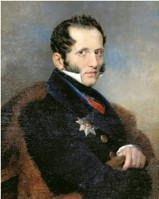
University Charter of 1835 issued
July 26 (August 7), 1835 in Russia was introduced a new university charter, one of the initiators and developers of which was the Minister of Education, S. S. Uvarov.
The first university charter was approved in Russia 12 (23) January, 1755 as the "Project on the Establishment of the Moscow University." Then, due to the opening of new universities in Vilna, Kazan and Kharkov 5 (17) November 1804 was issued the first General University Charter, which established the autonomy of universities.
July 26 (August 7) 1835 was introduced the new university charter, which promoted the importance of administrative hierarchy, especially that of the trustee of the school district and the rector as its representative at the university. Trustee had a central role in the university hierarchy. He could freely appoint a board meeting and take on the function of the chairman. Rector was given the right to really control over the education process and the quality of teaching. University Council focused on solving the problems directly related to the educational and research activities. Rectors candidacy under the decree were approved by the emperor, and that of professors – by the trustee.
Charter of 1835 established a strict police supervision of students, were introduced the posts of the inspector and his assistants, performing administrative and police functions.
However, the importance of universities and of university education rose too. The main innovation of the second university charter was a strict order of the educational process and in particular setting the state control over the quality.
There were significant changes in the structure of the university: instead of four faculties the new charter provided three of them: instead of the previous faculty of moral and political science with the department of philology there was implemented the faculty of philosophy which included two departments – philosophical and physic-mathematical. At the same time, part of the department of philology was transformed into an independent department – that of law.
The apprenticeship at universities increased from three to four years. There was introduced a two-year fellowships for young scientists from Russian universities abroad. Education was expanded and deepened through the introduction of new courses, and attention to classical education. Under the new charter the number of professors and departments significantly increased.
In addition, the material support of universities significantly improved as well.
During the reign of Alexander II in 1863 was published a new General Charter of Russian Universities, which restored their autonomy.
Lit.: Глинский Б. Б. Университетские уставы (1755-1884) // Исторический вестник. 1900. № 1, 2; Отечественные университеты в динамике золотого века русской культуры / Олесеюк Е. В., Борисов В. М., Динес В. А. и др. СПб., 2005. Гл. 2. § 2.2: Общий университетский устав 1835 г. и углубление вузовской реформы; То же [Электронный ресурс]. URL: https://lexed.ru/obrazovatelnoe-pravo/knigi/detail.php?ELEMENT_ID=1764; Петров Ф. А. Формирование системы университетского образования в России Т. 3: Университетская профессура и подготовка Устава 1835 года. М., 2003; Посохов С. И. Уставы российских университетов XIX в. в оценках современников и потомков // Вопросы образования. 2006. № 1; Рождественский С. В. Исторический обзор деятельности Министерства народного просвещения. 1802-1902. СПб., 1902.
Based on the Presidential Library’s materials:
Полное собрание законов Российской империи. Собрание 2. СПб., 1836. Т. 10. № 8337. С. 841;
Сравнительная таблица уставов университетов 1884, 1863, 1835 и 1804 гг. СПб., 1901.

